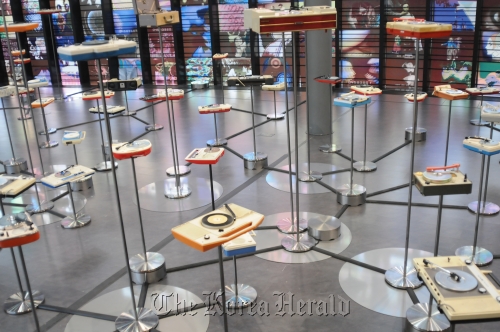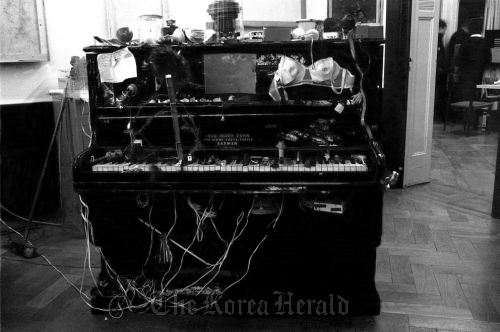
Otomo Yoshihide and Yasutomo Aoyama’s “Without Records” installation. (Nam June Paik Art Center)
Although the rest of the audience gasped in horror, John Cage broke out in laughter when Paik Nam-june cut off his necktie in the middle of a piano concert.
The South Korean artist had suddenly leaped down to Cage during his 1960 performance of “Etude for Piano Forte” in Cologne, Germany.
The U.S. composer and artist was probably one of the few in the audience who understood and enjoyed Paik’s performance, which ended with a phone call from Paik, who had left the room soon after the act.
“It was Paik calling to say the performance is finished,” the receiver announced to the awe-struck audience.
Photos capturing the monumental incident and Cage’s amused expression are on display at a special exhibition at Nam June Paik Art Center in Yongin, Gyeonggi Province. Commemorating the centenary of Cage’s birth as well as the 80th anniversary of Paik’s birth this year, the art center is shedding light on the two artists and their influence on today’s artists.

A photo of Paik Nam-june’s 1946 work “Klavier Integral.” (Nam June Paik Art Center)
“Not just us but many critics all over the world are interested in the two artists’ relationship. The biggest guide in organizing this exhibition was in fact Paik’s writings. He was the very person who most wanted to introduce their works to Asian countries like Japan and Korea,” said Ahn So-hyun, one of the three curators of the exhibition.
The two masters were more than contemporaries. Cage was Paik’s mentor, to the point that Paik said that his life started on an evening in August 1958 when he met Cage; and Paik was Cage’s inspiration.
Both enjoyed shattering the conventions of the art world and experimenting with the traditional concept of art and music. Cage’s performance “4’33”,” for example, in which the performer sat still in front of a piano for 4 minutes and 33 seconds, is considered a revolutionary moment in the history of art, as well as music. Paik’s installations using television sets are regarded as the start of the era of media art.
The exhibition, “x-sound: John Cage, Nam June Paik and After,” whose title refers to the sounds one can hear at the limits of auditory perception as a result of various temporal and spatial experiences, presents sound-related artworks by Cage, Paik ― most of which pay homage to Cage ― and 12 young artists.
The curators categorized works by Cage and Paik that share the same theme, like the reproduction of Cage’s 1946 piece “Prepared Piano” and video clips of Paik playing his 1963 work “Klavier Integral.” Cage placed objects like screws, nails or bamboo pieces on and between the piano strings to incorporate noise and percussion sounds to his music. Touched by the work, Paik added more aggressive elements to his piano, like barbed wire, toy cars, light bulbs and a bra.
The chronology of the two artists and photos and video clips of the two together, performing or talking, can also be found at the show.
Works by young Korean and international artists, obviously influenced by the two avant-garde artists, are not any less interesting.
Korean artist Rhee Sei’s “Syncopation for Long Standing One in Corridor,” for instance, greets viewers with electronic music sounds even from when they have barely reached the work.
Listeners naturally turn their heads toward the source of the sound, which is surprisingly up high, from tens of tiny speakers attached to a chair hanging from the ceiling. Dozens of other peculiar objects hanging from the ceiling buzz out unfamiliar noises as well.
Japanese artists Otomo Yoshihide and Yasutomo Aoyama fill a large exhibition space on the second floor of the center with about 100 old record players. The outdated gadgets seem like a cluster of junk at first glance, but make one take a second look by abruptly turning on at the same time “Without Records,” as the title hints.
The exhibition runs through July 1 at Nam June Paik Art Center in Yongin, Gyeonggi Province. Tickets range from 1,000 won to 4,000 won. For more information, call (031) 201-8512 or visit www.njpartcenter.kr.
By Park Min-young (
claire@heraldcorp.com)






![[Weekender] How DDP emerged as an icon of Seoul](http://res.heraldm.com/phpwas/restmb_idxmake.php?idx=645&simg=/content/image/2024/04/25/20240425050915_0.jpg&u=)
